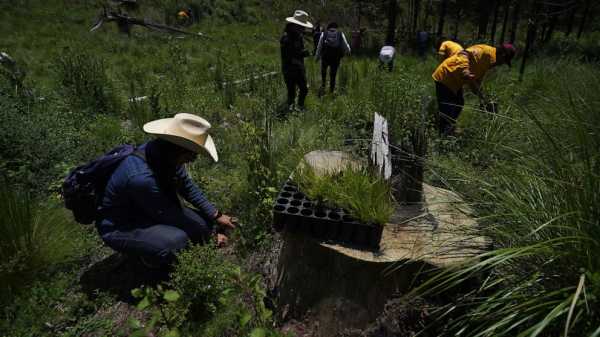
MEXICO CITY — It’s a strange scene: in the forest-covered mountains of Mexico City — which most people outside Mexico don’t know exist — a brigade of farmers and forest rangers plant inches-high pine saplings in a recently cut stand of trees, even as the sound of chainsaws can be heard nearby.
Illegal logging has taken a huge toll in recent years on the forest-covered southern half of the city of 9 million inhabitants.
“They have finished off the forest,” Alfredo Gutiérrez, 43, said with sadness.
The extent of the devastation is astonishing. Just a year ago, “it was always dark, even if the sun was shining, because of all the trees that were here,” Gutiérrez said of the grove near his town of San Miguel Topilejo — on the edge of the encroaching urban sprawl.
While most people associate Mexico City with traffic jams and polluted air, actually about one-half of the city’s territory is rural, almost all of it in the southern boroughs of Milpa Alta and Tlalpan. About 20% are protected nature areas, like the mountains covered with pine and fir forests that adjoin the neighboring state of Morelos.
Those trees guarantee the recharge of aquifers that supply nearly 20 million people living in the city — and its suburbs. They also help clean the polluted air of the city and serve to contain high temperatures.
Why the illegal tree cutting has gotten so bad so fast is a matter of debate.
Local farm communities — many of whose members are paid as park rangers or soil conservation workers by the city government — think that organized crime gangs have moved into the illegal logging business.
It would not be a far stretch: Such gangs have long used the rural communities on the city’s edge to set up safehouses to hold kidnapping victims and its forests as dumping ground for the bodies of their victims.
Some of the villagers suggest the federal government’s crackdown on the sale of contraband gasoline and diesel stolen from government pipelines may also play a role, saying those who used to make a living selling fuel at roadside stands may now have turned to logging.
Mexico City authorities say they have identified criminal groups behind illegal logging, and in the past few months they have struck back, mounting operations involving hundreds of police officers and soldiers who raided clandestine sawmills in the mountains.
The city also sponsors reforestation efforts, but it is a race against time. Many of the tiny saplings won’t survive, and it would take decades to replace the majestic mature forests being cut.
In 2010, forests covered about 100,000 acres (40,500 hectares) of the city’s total area of 370,000 acres (150,000 hectares), according to the activist group Global Forest Watch.
The group says the city lost 121 acres (49 hectares) of forest in 2022 — as much as in all of the four previous years together.
The problem is particularly acute in San Miguel Topilejo, which — because it has forests and is crossed by highways — makes it an attractive place for gangs to cut logs and move them to sawmills.
Pablo Amezcua, a natural resources engineer who works in San Miguel Topilejo, said that before 2020, only about 500 acres (200 hectares) had been affected by logging. Amezcua says that by mid-2023, a total of about 6,000 acres (2,400 hectares) had been fully or partially cut.
Combating illegal loggers is a Sisyphean task.
According to data from the country's attorney general for environmental protection, there have been 122 illegal logging complaints since 2013 in Mexico City, with more than half of those so far in 2023.
On a recent day, a group of forest rangers and volunteers set out on a reforestation mission in trucks from San Miguel Topilejo, going down narrow dirt tracks in the forest that are barely wide enough for the small trucks to pass.
They were escorted by soldiers and armed officers of the National Guard.
At the wheel of one of the trucks, a 24-year-old looked nervously from side to side as he piloted the vehicle. Like many of the rangers interviewed for this story, he asked not be named citing security reasons.
He said that when he passed the same spot two days before, there were trees where now there are felled branches and heaps of pine boughs, which could be dangerous fuel in the next forest fire season.
Riding next to him is a 58-year-old ranger who says he was shot in his abdomen by illegal loggers he tried to stop in November. A year before he says he was forced to flee his community after his family received threats.
Sadly, his situation is not unusual. Mexico is the world's deadliest place for environmental and land defense activists, according to a 2022 report by the nongovernmental group Global Witness. Mexico saw 54 activists killed in 2021, the highest number in the world.
The fact the forests have survived is itself a feat.
As Mexico City’s population exploded between the 1950s and 1970s, urban sprawl crept steadily up the forested mountain slopes on the city’s southern boroughs. All kinds of logging had already been prohibited but some believe the prohibition fueled illegality.
Marina Robles, the head of Mexico City’s environment department, said the causes behind illegal logging are many, from real estate interests to organized crime.
For starters, organized crime gangs that were once content to use the forests as a hide-out and body-dumping ground, now want to control every activity, licit and illicit, that occurs on what they consider “their” turf. That includes illegal logging.
A couple of months ago, local residents — left to their fate against the gangs — protested by blocking highways leading out of the forest.
In response, authorities started the raids in June, with the help of 500 soldiers.
By early August, acting Mayor Martí Batres said authorities have identified al least five organized criminal logging groups in the city and had seized 32 lumber yards and 28 illegal sawmills within city limits. A dozen more sites were found in the neighboring state of Morelos.
Most were semi-portable, fly-by-night operations.
“They find a place that has the right conditions, they set up the sawmills, cut down trees, all very rapidly, from one day to the next; they start milling the logs and then pack up the sawmill,” Batres said.
He hopes to pass tougher penalties for illegal logging but, at present, it is hard to even arrest illegal loggers, who have attacked rangers and even soldiers, at one point dousing an army patrol with gasoline.
In return, some local residents set fire to logging trucks.
But it is an unequal battle.
“They have high-powered rifles,” said the ranger who was wounded in November. “These criminals completely out-gun us.”
___
Follow AP’s climate coverage at: https://apnews.com/hub/climate-and-environment
Sourse: abcnews.go.com






